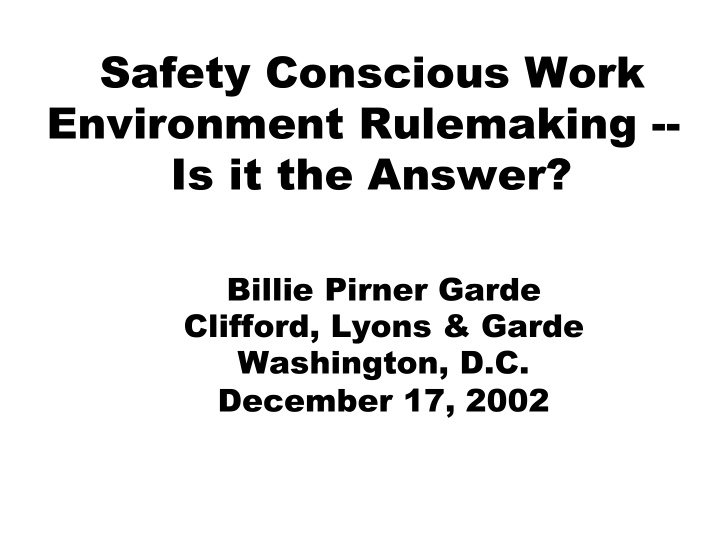



Safety Conscious Work Environment Rulemaking -- Is it the Answer? Billie Pirner Garde Clifford, Lyons & Garde Washington, D.C. December 17, 2002
Key Question: Do current NRC processes assure the free flow of information from employees about potential safety concerns? 2
Current Agency Process • No comprehensive programmatic approach to handling of retaliation complaints • Current process result of thirty years of reactive policy development 3
Current Agency Process (continued) Present HIRD/50.7 process viewed as having serious flaws - untimely, ineffective inconsistent and - unfair to those raising allegations and to those accused - is not transparent 4
Current Agency Process (continued) - Does not improve safety - Does not protect employees from retaliation - Does not enhance public confidence 5
Finding A Path Forward • Establish “results oriented” evaluation and oversight process • Require licensees to establish and maintain a SCWE with clearly defined attributes and performance indicators • Require licensees to comply with 10 CFR §50.7 and DOL regulations for responding to HIRD events 6
Safety Culture Defined “Safety culture is that assembly of characteristics and attitudes in organizations and individuals which establishes that, as an overriding priority, nuclear plant safety issues receive the attention warranted by their significance.” 75-INSAG-4 7
Common SCWE Attributes - Management commitment - A questioning attitude - Conservative decision making - Mutual trust of workforce - Alternative avenue, i.e., ECP 8
Common SCWE Attributes (continued) - Open communication - Reward for SCWE behaviors - Safety ahead of production - Zero tolerance for retaliation - Training programs - Robust corrective program action 9
SCWE Performance Indicators - Subjective and objective measurement tools - Unique to individual work environments - Consistent with size of program, degree of risk, historical performance 10
Benefits of SCWE Rule • Proactive regulatory program to upgrade industry performance • Comprehensive regulatory program for SCWE, HIRD (OI and IE), §50.7 and §50.5 issues 11
Benefits of SCWE Rule (continued) • Provides incentives for self- critical analysis on HIRD issues • Promotes early resolution of disputes • Does not increase regulatory burdens on licensees 12
Risks of SCWE Rule • Perception of NRC abandonment of HIRD issues by management and employees • Unhealthy work environments require substantial effort and oversight 13
Process Issues: SCWE • SCWE rulemaking will provide opportunity for public debate and discussion • “Pilot projects” should be tested on different types of licensees and results considered in rulemaking process 14
Process Issues: SCWE (continued) • Any “interim” measures should be developed with stakeholder input and Commission approval prior to implementation • Employee and public confidence critical to success 15
Process Issues: HIRD/50.7 • NRC process limited to safety impact and “chilling effect” – does not address individual remedies • DOL process limited to individual remedies, resolutions and settlements – does not address “chilling effect” or safety impact 16
Process Issues: HIRD/50.7 (continued) • NRC can and must enforce “zero tolerance” for retaliation by licensees • NRC can and must assure accountability for intentional retaliation 17
Conclusion • SMRT (Option 3) in SECY-02-0166 provides opportunity for significant improvement from present process • NRC would not abandon any of its statutory rights or responsibilities 18
Recommendation • Initiate public rulemaking on SCWE, including common SCWE attributes and indicators • Identify “pilot project” locations • Develop “interim” measures with public comment and Commission approval 19
Recommend
More recommend